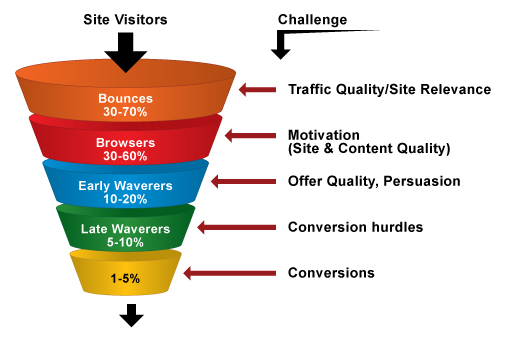Five years ago, you’d have been taking quite a risk by spending your marketing dollars on a Twitter or Facebook campaign. Today, mobile browsing and the combination of traditional media and social channels are changing the way we interact with the web.
Keeping up with these changes takes a solid understanding of your brand and your customers. Thankfully, you can consult a variety of tools to help track and quantify your efforts to maximize your ROI.
When you pull up the Google Analytics dashboard for your site, there’s an array of graphs, charts, and stats. If you don’t understand what you’re looking for, this data can seem overwhelming, but everything you need to know about the success of your website can be deduced using the following key metrics:
1. Conversion Rate
Your conversion rate shows how successful your website is in driving the desired action, whether that’s filling out a contact form or turning a visitor into a customer. While it doesn’t always indicate a sale, your conversion rate does show movement down the sales funnel. Keeping an eye on your conversions can show you the impact of any changes to your website and, therefore, the likelihood that those changes will drive more sales.
If a change (such as increasing the visibility of the “add to cart” button) should have improved your conversion rate but didn’t, you know you need to make further changes to improve your customer experience.
2. Channel Source
Customer acquisition is important, but you also need to know where your customers are coming from. Monitoring your channel source gives you a bird’s-eye view of which search terms, websites, or other marketing channels are driving traffic to your site.
If you reworked the SEO content on your site, your organic search results should improve. If you use a paid search campaign, you want to know how many clicks that campaign generated compared to your organic search.
3. Page Flow
Page flow shows you where your visitors are clicking on your website. Understanding where users are disengaging on your site helps you pinpoint what needs to be changed.
Is your shopping cart disappearing on certain browsers? Does the link text color blend in with the background? By tracking page flow, you can gain feedback on how to serve your customers better, improve conversions, and drive revenue.
4. Customer Acquisition Cost
Every business needs to know how much it costs to acquire a customer. If you only average $10 per transaction, but you have to spend $20 to bring in every customer, you won’t be in business for long!
Determining the cost of visitor acquisition, the percentage of visitors who turn into actual leads, the cost of lead acquisition, and the percentage of leads who become paying customers will give you the customer acquisition cost.
Your CAC will vary by channel, and some channels may be more expensive than others. As your brand recognition grows, your CAC should decrease.
5. Lifetime Value
It’s easy to focus on the number of one-off sales, but lifetime value is the true value of each individual customer. You want repeat customers because they don’t come with an acquisition cost. Satisfied customers will also tell their friends and family, bringing in more business at no additional cost to you.
Loyalty programs are the most common way to track and reward individual customer habits. Classifying customers this way focuses your marketing on your most profitable customers.
6. Marketing ROI
The return on investment for each marketing channel is your most important metric. You need to know how much of a return you get for the amount of energy and resources you’re expending. It’s true that all boats rise with the tide, but determining which marketing channel is the “tide” is valuable for allocating your resources most effectively.
Gathering and analyzing this data can be tedious, but it’s a necessary step in staying informed about how your business attracts customers and drives revenue. While it may move slowly at first, stick with it. The insights these metrics provide will pay off through dedicated customers who rave about your streamlined site and bring in even more customers.
Dave Chaplin is the CEO of SearchDex, a boutique SEO firm specializing in high-end e-tailers. He has a long history in online marketing, including working as VP of Advanced Search Technologies at Kroll Ontrack, stewarding the growth of Engenium, and directly managing the development of knowledge management technologies for KPMG.
Image Credit: www.picreel.com

